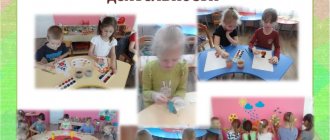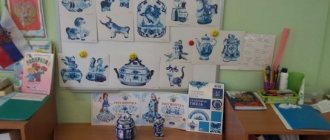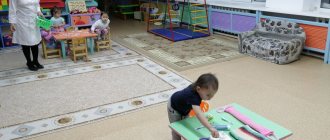GCD Self-Analysis
Tatiana Zvyagina
GCD Self-Analysis
Introspection.
GCD senior group “The Magic World of Butterflies”
Integration of educational areas: social-communicative, cognitive, physical development, speech development, artistic and aesthetic.
Educational field "Social and communicative development"
:
• encourage initiative and curiosity in order to consolidate acquired knowledge;
• develop the ability to answer the question posed with a complete answer;
• cultivate a caring attitude towards the environment;
• improve the ability to listen to a friend’s answer and not interrupt;
Educational field "Speech development"
:
• Activate children's vocabulary;
Educational field "Physical development"
:
• develop a sense of rhythm and tact (rhythmoplasty)
;
• develop fine motor skills of hands
Educational field "Cognitive development"
:
• To form children’s understanding of the life of a butterfly, its structure, vital activity, life cycles and species.
• consolidate active vocabulary on the topic;
• develop cognitive interest in nature
• develop attention and logical thinking.
Educational field "Artistic and aesthetic development"
:
• develop the ability independently convey images of objects using visual means and various materials: plasticine, beads, rope, felt, sequins, rhinestones, paper, stacks;
• develop creative abilities, a sense of beauty, aesthetic perception
Tasks:
Educational:
To form children’s understanding of the life of a butterfly, its structure, vital activity, life cycles and species; develop the ability to independently , creatively depict the “life cycle of a butterfly”
using artistic design; expand and enrich children's vocabulary.
Educational:
To develop cognitive interest in nature and cognitive abilities of children; develop imagination, sense of composition (plot lines)
creativity, communication skills.
Educational:
To cultivate responsiveness, the ability to demonstrate creativity and activity; cultivate curiosity, artistic taste and interest. creativity.
Direct educational activities, further NOD, were carried out with a group of children of senior preschool age 5-6 years old. The lesson consisted of three parts (stages)
interconnected, during which children gradually performed various actions.
This structure is completely justified, since each part (stage)
of the lesson is aimed at solving certain problems and offers a choice of methods and techniques. Goals and objectives correspond to the targets of the Federal State Educational Standard for Education.
Part 1 Organizational.
Motivation of children in upcoming activities. At this stage of the GCD, the method of game motivation was applied: the arrival of the “harbinger of spring”
.
Through breathing exercises, I got to know the children as a psychologically unloading, relaxing moment. Children were invited to go on a virtual journey to the "Magic World of Butterflies"
. GCD was a specially organized activity for children. They watched a presentation during which they became acquainted with the types of butterflies, their characteristics and life cycle.
Part 2 Was conducted by Ri
to a waltz from the ballet coppelia by composer Leo Delibes. In order to prevent fatigue, prevent poor posture, prevent the musculoskeletal system, respiratory system, psycho-emotional release.
Part 3 Productive activity It presented work on artistic design. The children were asked to make a butterfly cycle, gradually depicting the plot on a green leaf base. Using plasticine, beads, felt blanks, sequins. We reinforced the techniques of rolling a ball and rolling out a cylinder (giving it an oval shape)
.
The technique of attaching beads and superimposing a smaller figure in size onto a larger one. Create a beautiful composition “Birth of a Butterfly”
A surprise moment was used - a gift of green ribbons (bracelets)
. As a symbol of children's caring attitude towards nature. And a lapbook as a summary of the lesson.
She consolidated the positive results of the Reflection session with verbal encouragement.
To implement each task, I selected techniques that helped solve them. When working with children, I used conversation, asking children questions to test their intelligence and logical thinking. All this contributes to the effectiveness of GCD in children’s mental, creative activity and speech development. The material for ECD was selected at a level accessible to children, corresponded to their psychological characteristics and was rational for achieving goals and objectives. The children were active, attentive, and felt comfortable. All this confirms the results of our activities.
All elements of GCD are logically united by a common theme. The activities of NOD are characterized as joint and individual.
I used the following forms of work: frontal, individual, group.
The following methods:
— Verbal (conversation, riddles, questions are given from the point of view of the development of mental activity, the development of dialogical speech, poems, encouragement);
— Visual demonstration (multimedia installation - presentation on the topic “The magical world of the butterfly, pictures with the types and characteristic features of butterflies).
— Game (the arrival of the fairy-tale hero “the messenger of spring”
, breathing exercises, asking riddles, dancing using ri means
, green ribbons with flowers - as a symbol of respect for nature, an album (lapbook)
as the result of the lesson).
— Practical (artistic design)
The game form of the lesson, the novelty of artistic design. Contributed to the successful solution of assigned tasks, the formation of certain skills in artistic design. And what is especially important is the development of creative abilities. Children's positive emotions were enhanced by the use of audio recordings.
Working together with children, I tried to establish stable contact with them, thus creating a creative workshop where everyone is engaged in one thing - art.
I believe that the form of organization of children’s educational activities I chose was quite effective and dynamic. I tried to comply with the norms of pedagogical ethics and tact. I believe that the tasks assigned to the NOD were completed.
GCD has achieved its goal!
Difficulties and questions
I have already raised this topic in the article “Self-analysis of a teacher: how to compose it correctly?”, but despite the presence of many methodological recommendations in the literature and the Internet, my colleagues, especially young ones, have difficulties in this matter. I've talked before about the general self-reflection that goes into a portfolio. And today I will write about self-assessment of any activity that is conducted in kindergarten.
It should be understood that such documents are like a professional autobiography, but not just listing reliable information about periods of life, but with an analysis of mistakes and achievements. A self-respecting teacher will make every effort not to submit a poorly compiled analysis of the work done to management for review.
If you ask a truly adequate methodologist what he or she wants to see as a self-analysis of the lesson, then I am sure he or she will answer the following: “I want to read a logically structured, competent, reasonable self-analysis, supported by specific facts.” Do you, colleagues, think I understand the requirements for this document correctly? Respond, dear teachers!
It is no secret that even experienced educators, who will carry out any event with a bang, when writing an analysis then stumble on the wording of sentences. I’m like that myself, although I have to write a lot of things both at work and on the blog. But here natural laziness helps me: in order not to do extra work every time, I worked hard once, but made a kind of matrix - a sample for myself and now I will share it with those who need help.
Let's look for answers on the Internet...
I will not change the established tradition - to make for you a selection of useful, in my opinion, books and manuals.
So, after searching in UchMag, I found something special:
A bestseller in popular psychological literature, a book by an outstanding woman – Karen Horney “The Psychology of Women”. The language of the book is relaxed, funny, the topic is relevant for representatives of the weaker sex, so to speak - how to overcome internal conflicts and how to recognize the psychotype of the people around you. In addition, the author publishes a unique technique - an example of personal introspection. I think this is a very interesting book that will be useful to any woman.
As for professional activities, I advise you to pay attention to the electronic manual “Performance Map of the Professional Activities of a Teaching Worker.” This is a CD with guidelines for creating self-reflections, portfolios, etc.
The printed manual “Self-analysis of the educational process: analytical activity, structure and content” is intended for heads of educational institutions to provide a scientifically based system of activity and management.
I understand that I haven’t presented you with many manuals on the issue of step-by-step compilation of self-analysis for a lesson, but I have already written and recommended thematic manuals on this topic several times, but I don’t want to repeat myself.
What difficulties arise when compiling a self-analysis of a lesson?
Despite the fact that I have a younger group, the recommendations for writing self-analysis are common to everyone, so don’t be shy, take my work and use it for your health.
So, first, let's look at the mistakes that we all make when analyzing an event. When we begin the textual part of self-analysis, we get carried away with describing the process of the lesson, but forget to formulate the problem that we planned to solve through a specific lesson.
For example, you conducted a lesson on the topic “Vegetables” in a middle group or in any other group. What problems or tasks do we want to solve with this theme? After all, it’s not just that a lesson in kindergarten is planned, but with the goal of achieving something, isn’t it? This means you need to write, like, that there is a problem with the development of fine motor skills and vocabulary in children. Since these concepts are interrelated, during the lesson the problems will be solved comprehensively.
In general, the problems that we can put in the introductory part (preamble) of introspection are quite typical:
- Speech development;
- Development of fine motor skills;
- Activation of creative abilities;
- Improved communication;
- Socialization of children, etc.
It is better if the problem is consistent with the topic of self-education. And do not forget that the problems are also closely related to the age groups of children. For example, in a pre-school group, be sure to focus attention in posing problems on a topic that corresponds to the trends of modern school education.
In addition to posing the problem, educators often forget about the need to indicate the difficulties encountered during the lesson. It is believed that a good teacher cannot have any shortcomings in his work. But we all know that everyone has their own weaknesses, and the ability to highlight them is not an indicator of inexperience, but, on the contrary, demonstrates your objectivity in relation to yourself.
It also happens that the teacher is interested in statistics: the text is replete with numbers and percentages. But it’s better not to go too far with this. The structure of self-analysis does not presuppose dry statistics, but a clear presentation of the results of a study of the justification for using a particular technique when conducting a specific lesson.





